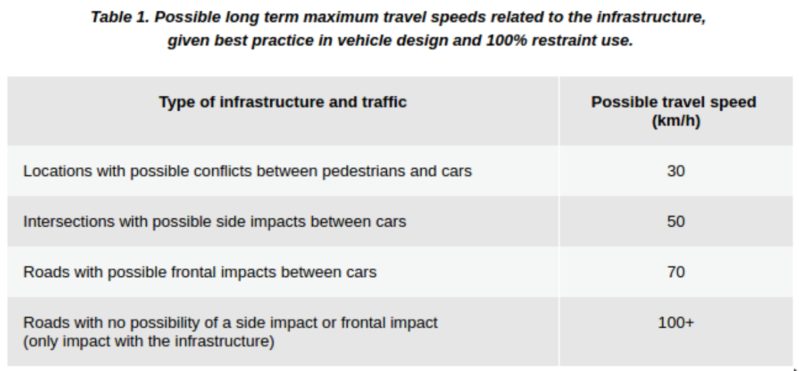
I’ve written about Vision Zero before in the context of Volvo, which made a pledge some years ago to have none of their customers die or be seriously injured by the year 2020. Whether or not they achieve this goal, the core value behind the Vision Zero approach (approved in Sweden in 1997 and brought to a growing number of additional countries, including the US) is that the death and destruction caused by the automobile does not have to be a given, and that we can, should, and must work to reduce the negative impact of the automobile on human life.
I fully agree with this goal, and it’s a guiding principle behind the articles I write on this blog. Yes, it’s great to get safer vehicles, but we also need to remember that the greater goal must involve the protection of all citizens, including those who don’t have access to the safest vehicles due to financial reasons, such as the poor and elderly, or those who can’t or use cars, trucks, and SUVs at all, like cyclists, motorcyclists, children, and pedestrians.
Is Vision Zero Working, and who should we learn from?
It’s worth noting that Sweden has improved their road safety to the point of becoming one of the global leaders in the minimization of deaths and serious injuries. In 1997, their per capita auto death rate was approximately 7 per 100,000; today, they’re among the top nations on the planet with a rate of 2.8/100,000 in 2014. The US, in comparison, had a death rate of 10.2/100,000 in 2014.
Vision Zero is working in Sweden, as well as in other countries around the world that have taken meaningful and consistent steps to adopt it (e.g., Norway, which also had a 2.8 per capita rate in 2014). It has not shown as much success in nations unwilling to fundamentally alter their principles in road design. It’s worth looking into some of the central tenets of the approach from people who work with it on a daily basis.
With this in mind, here’s an excerpt from a 2014 interview with Matts-Ake Belin, a traffic safety strategist in the Swedish Transport Administration. He’s one of the main figures behind VZ, and here’s what his team has found about the human body’s capacities to absorb injury. Much of this will ring true with policies I advocate on the blog.
What speeds make crashes unsurvivable in and out of vehicles?
…in Vision Zero, the accident is not the major problem. The problem is that people get killed or seriously injured. And the reason that people get serious injuries is mainly because people have a certain threshold where we can tolerate external violence, kinetic energy. And we know quite well now how much violence we can tolerate.
Right off the bat, Belin brings good information. Just as there is a limit to the number of individuals our planet can support, there is a limit to the amount of force the human body can manage. The VZ folks call it “external violence”, but whatever the terminology, the point remains the same: we can only absorb so much energy.
I’ve written about this endlessly in the context of frontal and side collisions in vehicles, as well as in reasons to rear-face instead of forward-face. When you rear-face a child, the energy in a collision is primarily distributed throughout the child’s back, which has a much larger surface area, mass, and ability to absorb shock than solely the child’s head and neck, which are charged with absorbing that same shock in a frontal collision.
In the context of crashes, I’ve repeatedly found that once the forces in a head-on or side collision exceed about 200% of the forces the vehicle was designed to support (i.e., the forces it withstood in a crash test where it received a “good” score), survival rates seem to drop rapidly from close to 100% to much, much lower odds (I’d estimate 67% at 200% of tested forces). At 300% of crash-tested forces, I’d estimate survival odds tentatively at around 33%. These aren’t good odds. And remember that the IIHS tests head-on and side-impact collisions at 40 and 31 mph, respectively. If you’re involved in a head-on collision at 70 mph, you’re already at 306% of the forces your vehicle was designed to keep you alive in. The odds are pretty strong that anyone in the front row is going to die. Similarly, if you’re t-boned at 55 mph, you’re already at 315% of the forces your vehicle was designed to keep you alive in. Once again, anyone on the impacted side of the vehicle is probably going to die.
One of the major things with Vision Zero now is to put that more explicitly on the table. It’s like if we’re talking about the environment, and you know you have a certain threshold when it comes to poison, or whatever. You can tolerate up to a certain level. So it’s not just to stop the traffic. You can actually allow traffic. But if you have places in your system where you have unprotected road users and protected road users, according to Vision Zero you can’t allow a higher speed than 30 kilometers per hour [18.6 mph].
Belin here underscores the logic behind the “20 is plenty” campaigns throughout Europe that are slowly (very slowly) making their way to the US. Actually, we’ve had an equivalent policy for decades in the US–it’s the reason why school zones throughout the country have 20 mph speed limits when children are present. The problem is that pedestrians, cyclists, motorcyclists, and children don’t get any of this protection unless they happen to be moving through school zones while children (and perhaps police) are present. But the physics doesn’t change. If you’re an unprotected road user (which basically means anyone who isn’t in a vehicle with a steel frame, closed doors, crash scores, seat belts, and front and side airbags), you can’t mix with protected road users (anyone in a car, truck, SUV, minivan, etc) at more than 20 mph, or else your odds of death in a collision rise rapidly.
Once again, speed kills. This time, much lower speeds kill.
This is huge. But what do our odds look like if we’re in protected vehicles? Let’s turn to a study done by Monash University in 1999:
 As you can see, this is where Belin got his numbers from. If pedestrians meet cars, traffic can’t move beyond 30 kph (18.6 mph). It just can’t.
As you can see, this is where Belin got his numbers from. If pedestrians meet cars, traffic can’t move beyond 30 kph (18.6 mph). It just can’t.
If individuals are in cars and wearing seat belts on roads with risks of side impacts, traffic can’t move beyond 50 kph, or 31 mph. This, not-coincidentally, is the typical speed in residential areas in the US. However, it’s frequently exceeded by drivers, and it’s already far in the danger zone for the kinds of individuals who are and should be everywhere in residential areas (pedestrians, children, cyclists, etc). Also note how that is exactly the threshold at which the IIHS tests side impact collisions.
If everyone is buckled in and in protected vehicles and there isn’t a risk of side impacts, the limit for frontal impacts is described as 70 kph, or 43.4 mph. Note again how this is right about where the IIHS tests its moderate- and small-overlap crashes.
Finally, if there isn’t a risk of side or frontal impacts due to barriers between opposing route traffic, the top speeds for well-designed vehicles and restrained passengers can exceed 100 kph, or 62 mph. However, this again requires the impossibility of head-on or side-collisions. When restrained in well-designed vehicles, we can handle collisions with forgiving barriers at high speeds. We can’t handle those collisions or speeds when interacting with other vehicles in head-on collisions. We’re even more vulnerable to side collisions. We’re at our most vulnerable when we aren’t in protected vehicles at all.
Best practices in survivability thresholds have been open knowledge for decades. But it won’t help us until we start designing our roads with this knowledge in mind.
We are all worth protecting, regardless of how we move.
—
If you find the information on car safety, recommended car seats, and car seat reviews on this car seat blog helpful, you can shop through this Amazon link for any purchases, car seat-related or not. Canadians can shop through this link for Canadian purchases.

